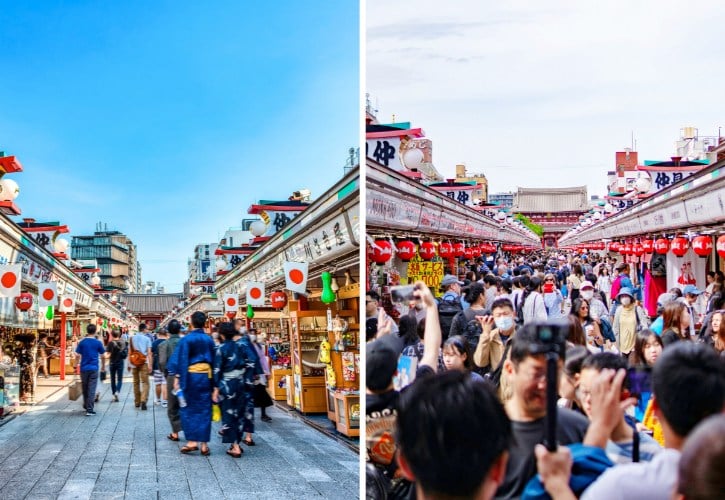
Pick the wrong week to visit Tokyo and you might spend twice as much on hotels and flights while struggling through crowded temples and trains.
Choose the right one and the city feels calmer, cheaper, and far more enjoyable.
In this guide, I’ll share the 5 best times to visit Tokyo, plus the months to avoid.
I hope this helps you plan a trip you’ll truly enjoy and save money too. 😊
Tokyo by Season: Prices, Crowds, and Weather in One Look
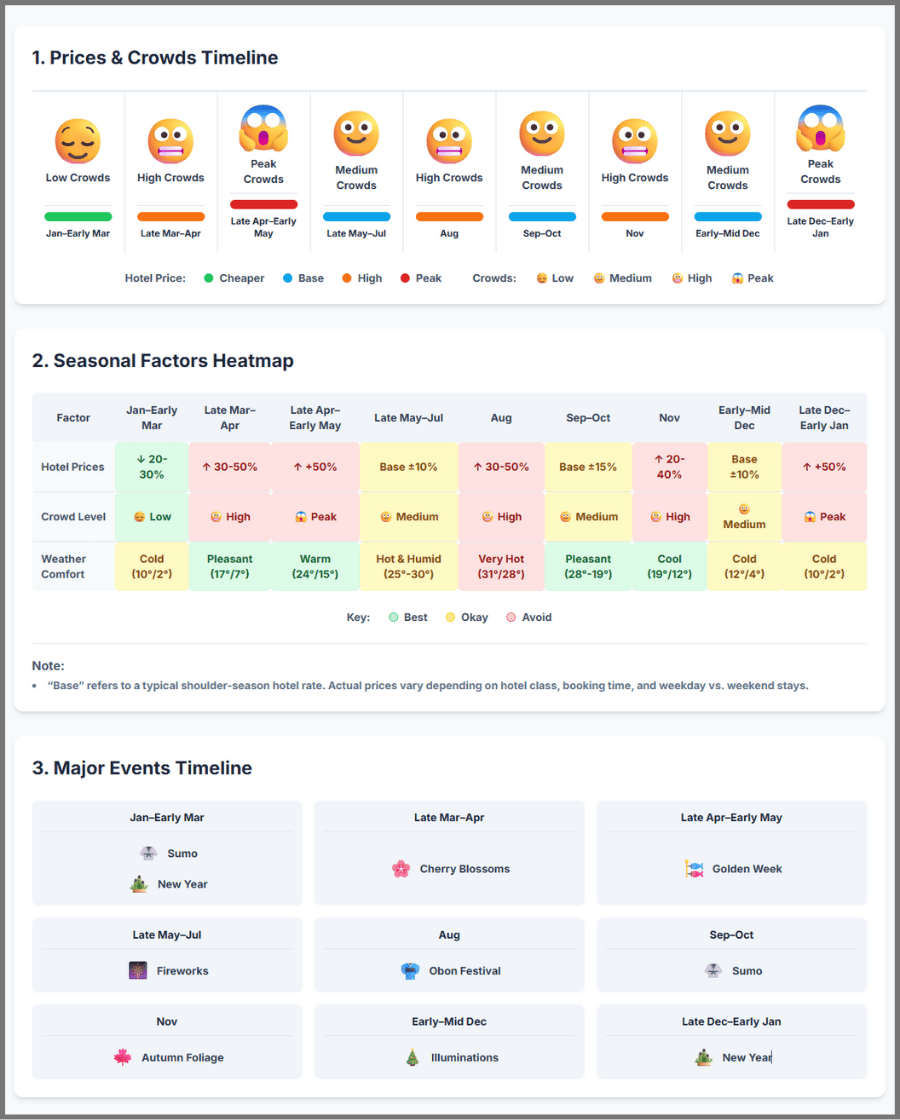
This chart gives you a quick, visual snapshot of what to expect in Tokyo each season.
You’ll see how hotel prices, crowd levels, and weather shift through the year, plus when major events happen.
The “Price vs. Base” shows how costs compare to a typical shoulder-season trip (our baseline).
The 5 Best Times to Visit Tokyo
These periods offer the sweet spot: pleasant weather, manageable crowds, and reasonable prices.
1. January – Early March (Winter Low Season)
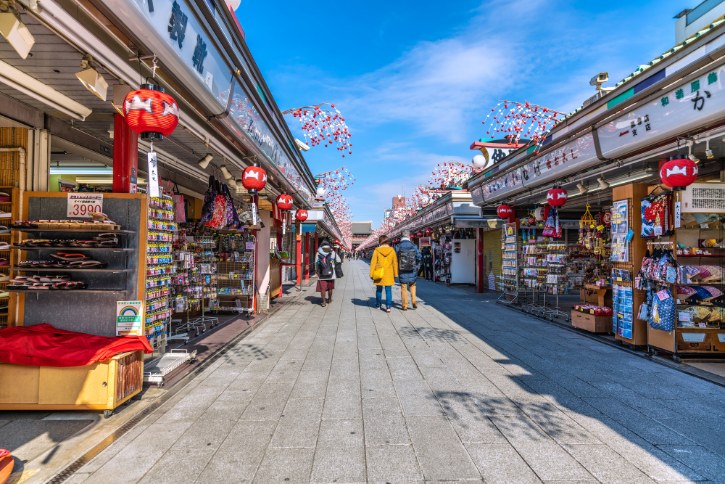
Best for: Low prices and quiet sights.
Tokyo’s winter is cold but not brutal. Think crisp, clear days perfect for photography, not the bone-chilling freeze of Chicago or Moscow.
Weather Snapshot
- Temps: 10°C/2°C on average
- Rain: Only 5–6 rainy days per month with low humidity
- Skies: Often sunny and dry, best chance to spot Mount Fuji from city skyscrapers
Pack a warm coat, gloves, and scarf. Indoors are well-heated, but evenings can be sharp.
Crowds & Prices
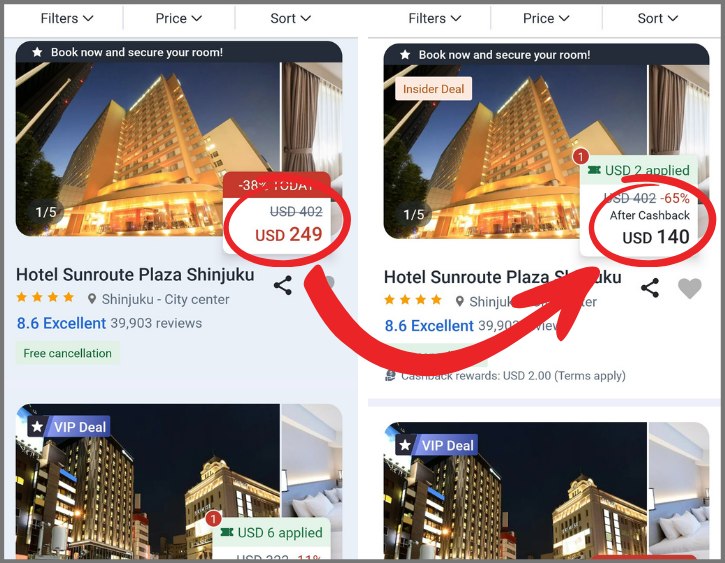
After the first week of January, Tokyo empties out. You’ll explore Senso-ji Temple and Meiji Jingu with plenty of personal space.
Prices drop 30–50% after early January. Mid-range Shinjuku hotels that cost around ¥37,000 ($249) in early January can fall to about ¥20,800 ($140) in February.
Key Events
- Grand Sumo Tournament (January): Ryogoku Kokugikan
- Setsubun (February): Bean-throwing festivals at temples to drive away evil spirits
- Plum blossoms (late February): A preview of spring at parks like Yushima Tenjin
Pros & Cons
Pros:
- Cheapest time of year for flights and hotels
- Short lines at museums and temples
- Clear winter skies for great views
Cons:
- Cold weather requires layering
- Parks are brown and sparse (no cherry blossoms)
Bottom line: If you don’t mind the chill, this is a peaceful, budget-friendly window to experience Tokyo like a local.
2. Late May – June (Early Summer Shoulder)
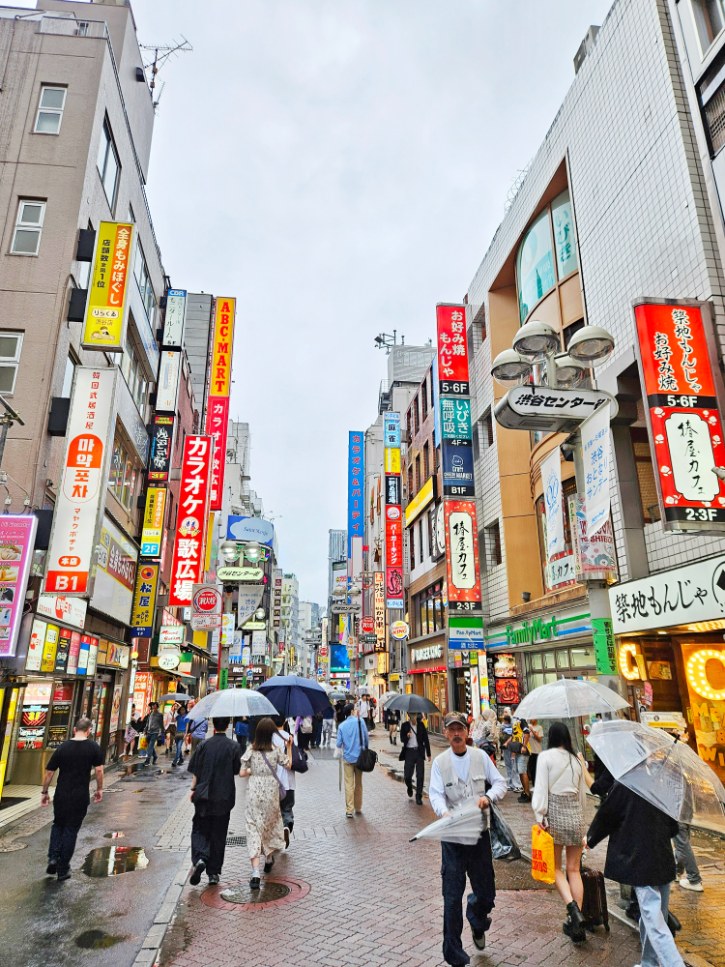
Best for: Lush scenery and fewer crowds after the spring rush.
Late May eases from pleasant spring weather into the rainy season (tsuyu), which isn’t nearly as bad as it sounds.
Weather Snapshot
- Temps: 24–26°C/15–19°C
- Humidity: Rises to about 75% in June
- Rain: The rainy season (early June to mid-July) brings frequent drizzles rather than typhoon-style downpours
June has the most rainy days (about 13), but total rainfall is actually lower than September’s typhoon season. Think overcast mornings and light showers, not trip-ruining storms.
Pack a good umbrella and waterproof shoes. Light, breathable fabrics keep you comfortable.
Crowds & Prices
The intense crowds of cherry blossom season and Golden Week have departed. Hotels that were fully booked in April now have vacancy and often 30-50% lower rates.
Prices are at baseline, making this a good benchmark for average Tokyo costs.
Key Events
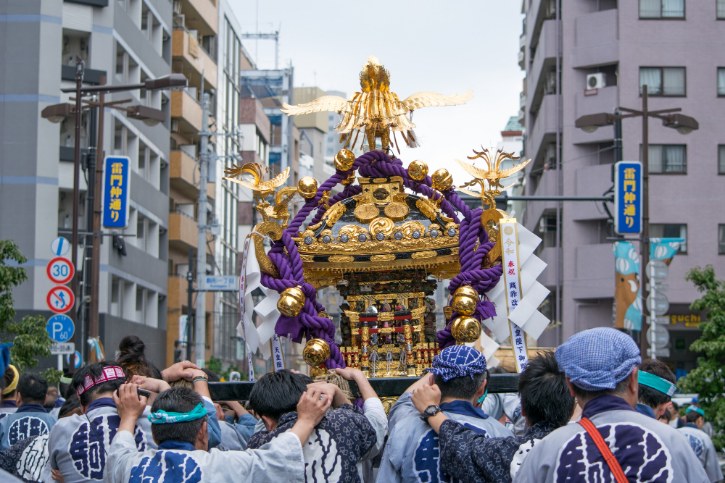
- Sanja Matsuri (May): One of Tokyo’s wildest festivals takes over Asakusa with about 2 million attendees
- Grand Sumo Tournament (May)
- Hydrangea blooms at temples in early June
Pros & Cons
Pros:
- Excellent value for money
- Parks and gardens at their greenest
- Indoor attractions (museums, shopping) thrive on rainy days
Cons:
- Higher chance of rain
- Humidity can feel sticky in June
- Not ideal for extensive outdoor hiking
Bottom line: With an umbrella and flexible schedule, this is a wonderful time to enjoy Tokyo’s cultural side without the tourist swarm.
3. September – Mid-October (Early Autumn Shoulder)
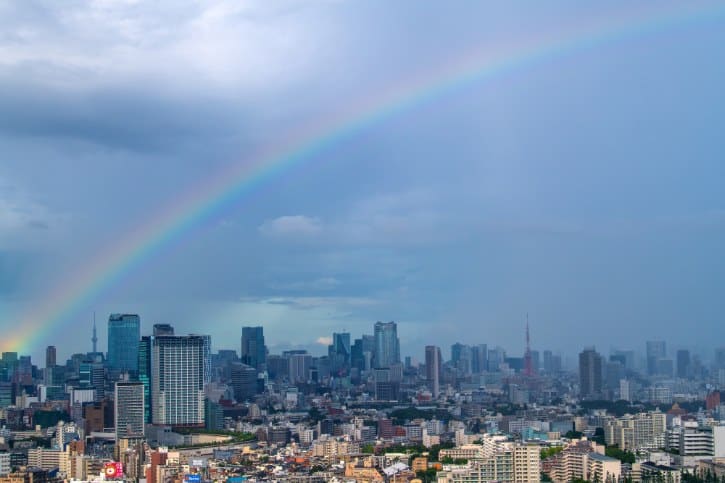
Best for: Great deals before the autumn rush if you can tolerate typhoon risk.
September starts hot and humid but gradually becomes more pleasant as autumn approaches. By early October, the weather turns genuinely comfortable.
Weather Snapshot
- September temps: 28°C/20°C on average
- Early October temps: 26°C/19°C, with crisp, clear days
- Humidity: Drops from 75% in September to about 68% by mid-October
- Typhoons: Peak season (August–September), with 1–2 likely hitting the Tokyo area. Risk decreases significantly by October.
Typhoons usually bring 1–2 days of heavy rain and wind, which can delay flights or stop trains. A direct hit during your trip is unlikely, but it’s best to stay flexible in September.
September is the wettest month, with short but intense storms. October is much drier, with around 8 rainy days.
If you want to avoid typhoons and heavy rain, aim for early October when the weather is pleasant and the risk has mostly passed.
Crowds & Prices
Summer vacationers have gone home. Autumn leaf-peepers haven’t arrived yet (foliage doesn’t peak until mid-to-late November). The city is relatively calm.
Prices drop about 15% below baseline. Hotels run fall promotions. Flight deals are common.
By mid-October, prices start creeping up slightly as autumn tourism builds, but you’re still well below the November peak.
Key Events
- Grand Sumo Tournament (September)
- Long weekends in September around national holidays (Respect-for-Aged Day, Autumnal Equinox)
Pros & Cons
Pros:
- Excellent value for budget travelers
- Moderate crowds
- Weather improves dramatically from September into October
- Comfortable sightseeing by early October
Cons:
- Typhoon risk in September (monitor forecasts)
- Early September still feels like summer
- Occasional heavy rain, especially in September
Bottom line: September is cheaper and less crowded but comes with storm risks, so stay flexible. October is drier, more comfortable, and still offers shoulder-season prices. Always keep one day open for indoor plans in case of bad weather.
4. Early to Mid-December (Early Winter Shoulder)
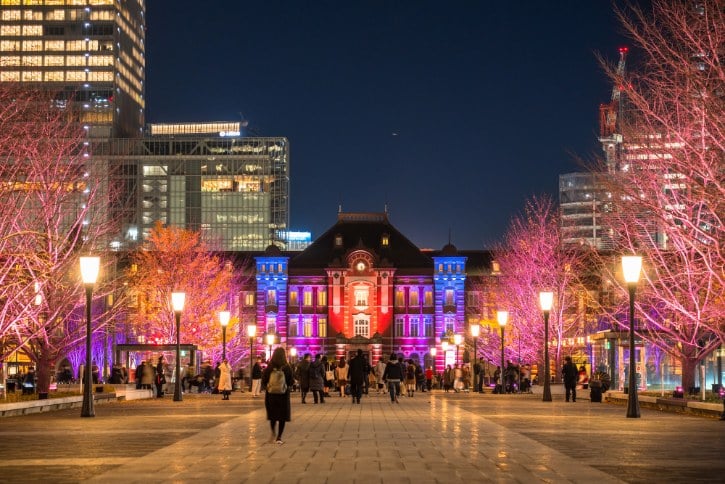
Best for: Festive lights and cool, comfortable sightseeing.
The first half of December offers Tokyo’s holiday magic without the holiday chaos.
Weather Snapshot
- Temps: 12°C/4°C
- Rain: Only about 5 days per month, one of the driest times of year
- Skies: Clear and crisp, perfect for walking tours
Pack a warm coat, scarf, and gloves for evenings spent outdoors.
Crowds & Prices
The autumn tourism wave has passed. The Christmas/New Year rush hasn’t started yet.
Prices are at baseline, rising to +10% by the third week. After December 20, prices skyrocket for New Year’s travel.
Key Events
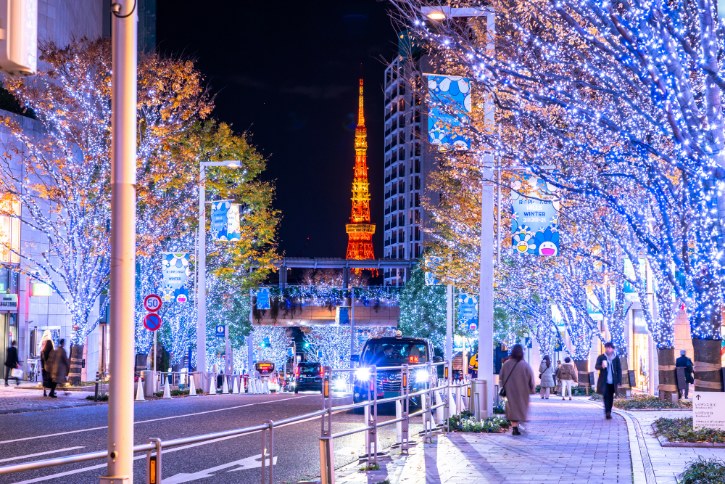
- Winter Illuminations: Entire districts (Marunouchi, Roppongi, Shibuya) draped in millions of LED lights from mid-November through Christmas
- Christmas markets: Pop up in mid-December selling mulled wine and crafts
Pros & Cons
Pros:
- Magical festive atmosphere
- Cool, dry weather ideal for sightseeing
- Good hotel and flight availability
Cons:
- Evenings can be quite cold
- Need to book before holiday price surge
Bottom line: A great time to visit. The crisp weather feels refreshing, and the light displays mix Western holiday charm with Tokyo’s own style.
5. July (Summer Shoulder)
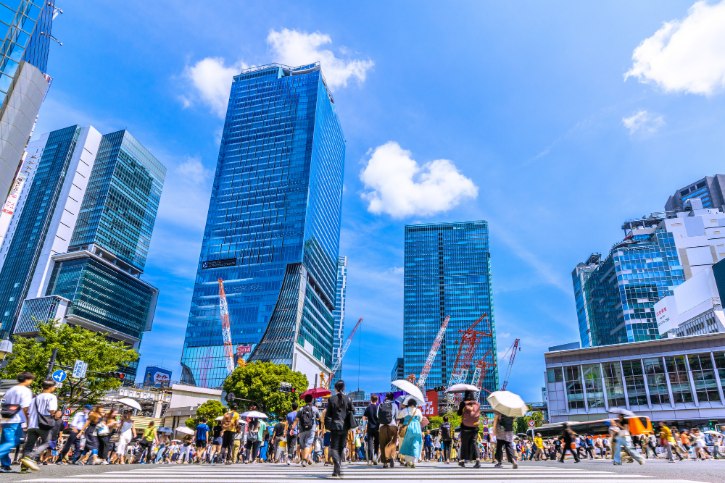
Best for: Summer festivals at lower cost if you can handle the heat.
July sits between shoulder and high season. It’s hot and humid, but you’ll pay less than in August while still enjoying vibrant summer energy.
Weather Snapshot
- Temps: 26–30°C
- Humidity: Extreme at about 75%, heat index can feel like 35–38°C
- Rainy season: Usually ends by mid-July, after which days become sunnier (and hotter)
Lightweight, breathable clothing is essential. Carry a hat, sunscreen, and refillable water bottle. Plan morning and evening activities; take AC breaks during midday heat.
Crowds & Prices
Less crowded than August. Many foreign travelers avoid Tokyo in peak summer due to the climate.
Prices are 10–15% above baseline, cheaper than spring/fall peaks. Flight prices climb in late July as summer holidays begin, so aim for early July.
Key Events
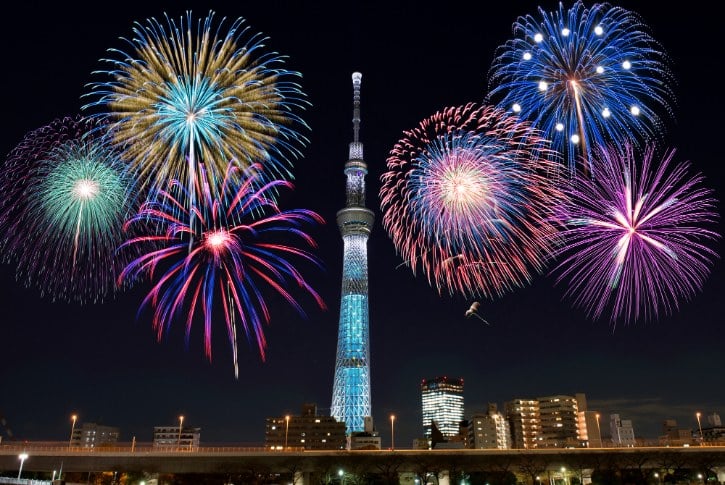
- Sumidagawa Fireworks Festival (July)
- Summer Festivals (matsuri): Neighborhoods host local festivals with food stalls, music, and dancing
- Marine Day holiday (July): Long weekend brings more domestic travel
Pros & Cons
Pros:
- Vibrant summer atmosphere with festivals and fireworks
- Lower prices than August
- Long daylight hours (sunset about 7pm)
Cons:
- Extreme heat and humidity
- Risk of heat exhaustion; pace yourself
- Early July may still catch rainy season tail
Bottom line: If you can shift to evening strolls, you’ll enjoy summer without overspending. Don’t miss seasonal treats like kakigōri (shaved ice) and rooftop beer gardens.
The 5 Months to Avoid
These periods bring overwhelming crowds, high prices, or challenging weather.
1. Late March – April (Cherry Blossom High Season)
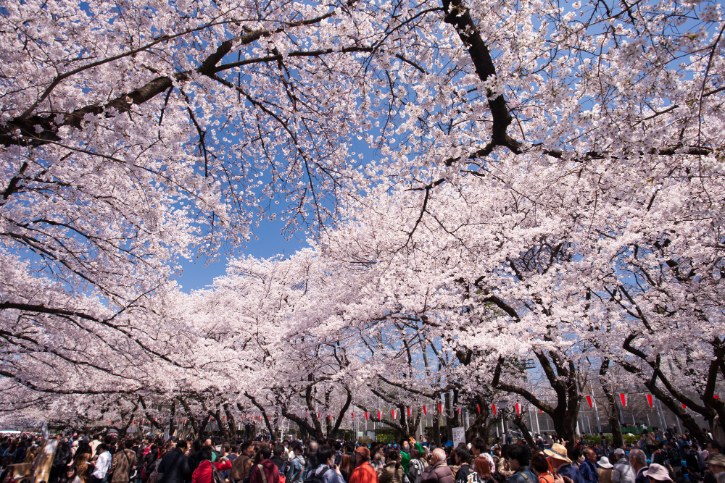
Why to avoid: Iconic but expensive and extremely crowded.
Cherry blossom season draws visitors in droves, both domestic and international.
Popular viewing spots like Ueno Park and Chidorigafuchi are packed shoulder-to-shoulder.
The Issues
- Extreme crowds: Lines to enter gardens, waiting times at restaurants, packed trains
- Peak prices: Hotels charge 30–50% more than baseline; some double their rates
- Booking nightmare: Must book 6–12 months ahead for decent hotel choices
- Timing gamble: Peak bloom lasts about 1 week and depends entirely on weather
Bottom Line
Unless seeing cherry blossoms is a lifelong dream, you can experience them elsewhere (smaller cities, earlier blooming regions) for far less hassle.
If you must come during sakura, book ultra-early and visit popular parks at dawn.
2. Late April – Early May (Golden Week)
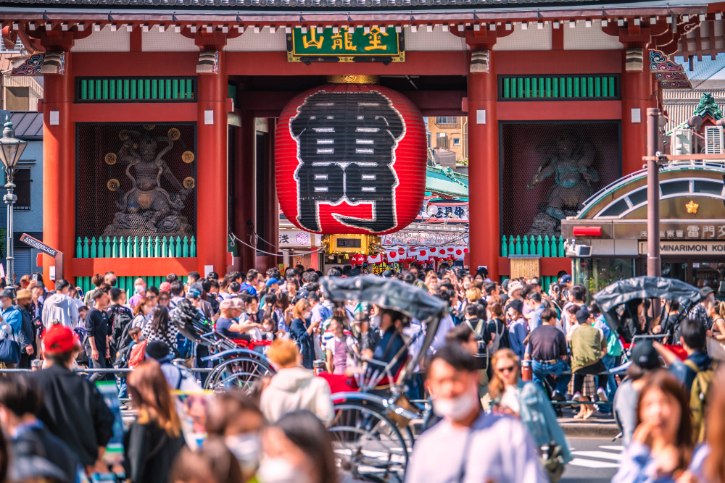
Why to avoid: Huge domestic crowds and sky-high prices.
Golden Week: A cluster of national holidays in late April and early May, creating one of Japan’s busiest travel periods.
The Issues
- Domestic frenzy: Bullet trains sell out weeks ahead; highways jam; tourist attractions at max capacity
- Prices surge 50–100%+, often the single most expensive week of the year
- Transport nightmare: Fully booked Shinkansen, people standing for hours on trains
- Some closures: Smaller family-run shops may close as owners take rare vacations
Bottom Line
Avoid traveling in or out of Tokyo during this period. If you’re already there, stick around and explore lesser-known spots.
3. August (Obon and Peak Summer)
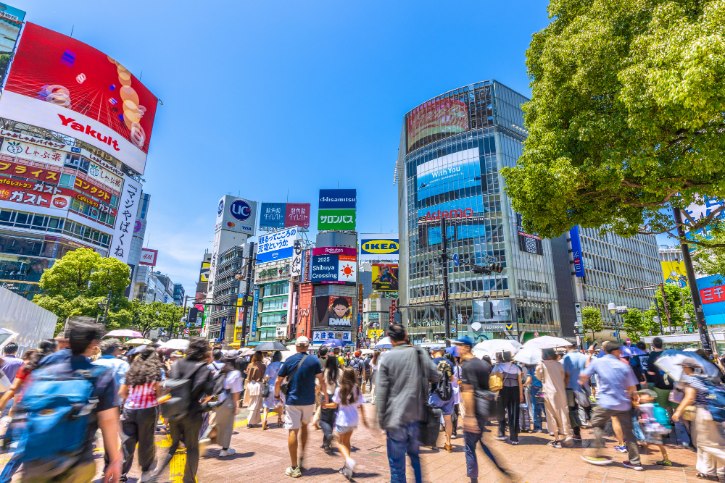
Why to avoid: Sweltering heat, packed crowds, and steep prices.
August combines the year’s most uncomfortable climate with peak summer tourism.
The Issues
- Oppressive heat: Hottest month at 31°C average, often feels hotter due to humidity
- Peak crowds: International summer vacationers + Obon domestic travel (mid-August)
- Prices up 30–50% for hotels
- Typhoon risk: Active season with potential storms
Bottom Line
Unless you have a specific event (concert, conference), avoid August. If you must go, plan indoor activities during midday and use air conditioning to stay comfortable.
4. November (Autumn Foliage High Season)
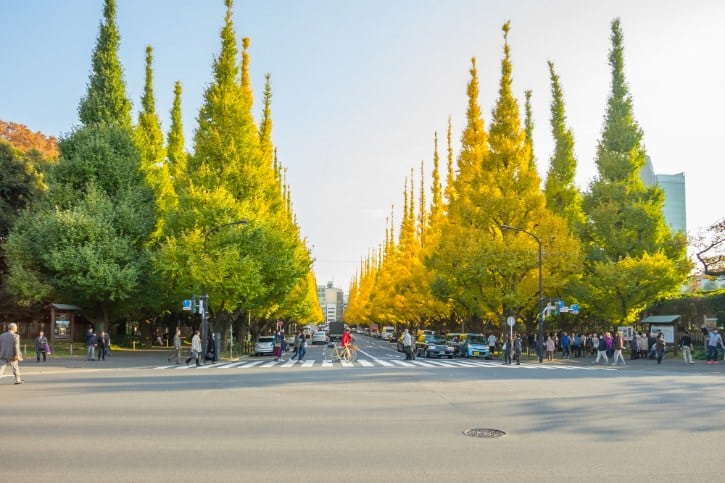
Why to avoid: Popular weather means high demand and inflated prices.
Autumn colors (kōyō) rival cherry blossoms for popularity. Mid-to-late November sees major tourist crowds.
The Issues
- High crowds: Famous gardens extremely busy, especially weekends when foliage peaks (mid-November to early December)
- Prices up 20–40% for hotels
- Booking pressure: Need to reserve 4–6 months ahead for good accommodation
Bottom Line
If foliage isn’t your main goal, skip the rush. If autumn leaves are a priority, visit in early December. Tokyo still has color, and many tourists have already left.
5. Late December – Early January (New Year’s Peak)
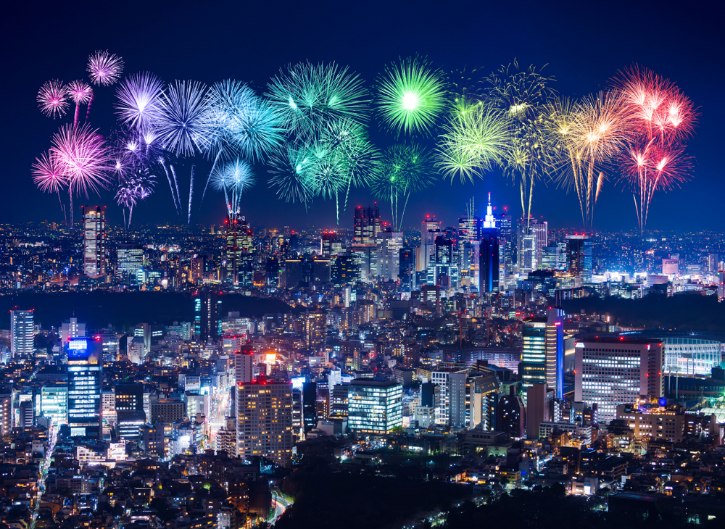
Why to avoid: Widespread closures + peak prices + transport congestion.
The Issues
- Widespread closures: Museums, gardens, shops, restaurants closed December 29–January 3
- Peak prices: Hotels charge 50–100% more over New Year’s Eve
- Crowds at shrines: Millions visit temples for hatsumode (first shrine visit); lines last hours
- Transport crunch: Bullet trains and highways jammed December 29–31 and January 2–4
Bottom Line
Unless you specifically want to experience Japanese New Year traditions (hatsumode, special foods, Emperor’s greeting), visit just before (end by December 26) or after (start January 4+).
Your Perfect Tokyo, Your Perfect Time
The best time to visit Tokyo depends entirely on your priorities:
- Cherry blossoms or autumn leaves? Prepare for crowds and costs.
- Budget and quiet exploration? Choose winter or shoulder seasons.
- Comfortable weather without peak stress? Try early summer or early winter.
Tokyo always has something amazing going on. Use these insights on weather patterns, events, and price swings to plan a trip that suits your comfort level.
Whenever you go, this city is ready to delight you. Have a great trip!
Related Posts
Photo Credit:
Photos by PIXTA

